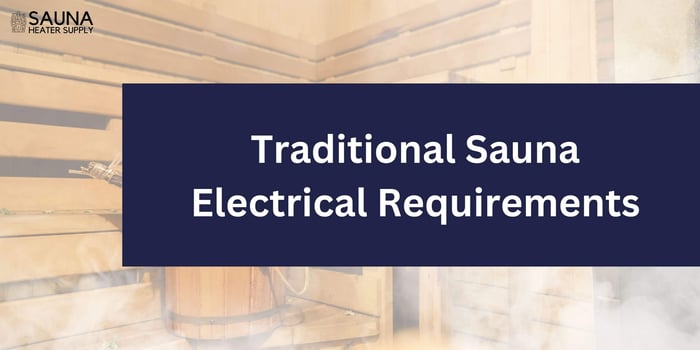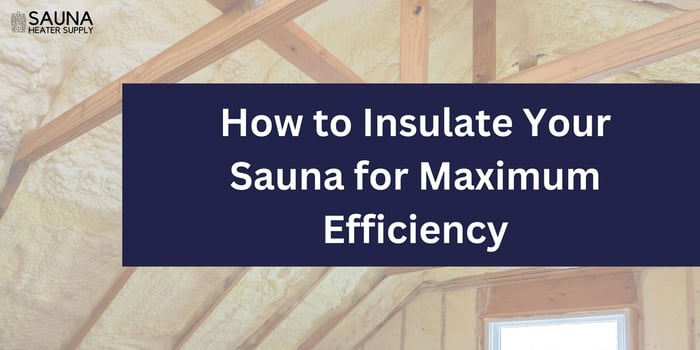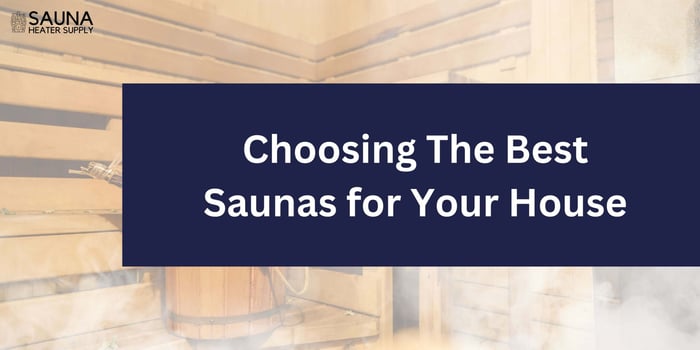Now that winter is behind us, many people are dreaming of having a sauna right at home (whether indoors or outdoors).
If you're considering a traditional electric sauna heater, it's essential to understand the importance of a proper electrical setup. Without it, your sauna simply won’t perform as it should.
While there are several traditional saunas, this guide focuses on electric models. We'll cover everything you need to know, from voltage and wiring to safety and installation.
And, disclaimer: If you're not experienced with traditional sauna electricals, it is ultimately ideal to consult licensed electricians for installation.
Table of Contents
- Understanding Sauna Heater Power Requirements
- Voltage Requirements for Traditional Electric Sauna Heaters
- Amperage and Circuit Requirements
- Wiring Considerations and Best Practices
- Quality Heater Options and Their Electrical Specifications
- Where To Buy Reliable Heaters For Traditional Electric Saunas
- Installation Considerations
- Troubleshooting Common Electrical Issues in Traditional Saunas
- Remember…
- FAQs
Understanding Sauna Heater Power Requirements
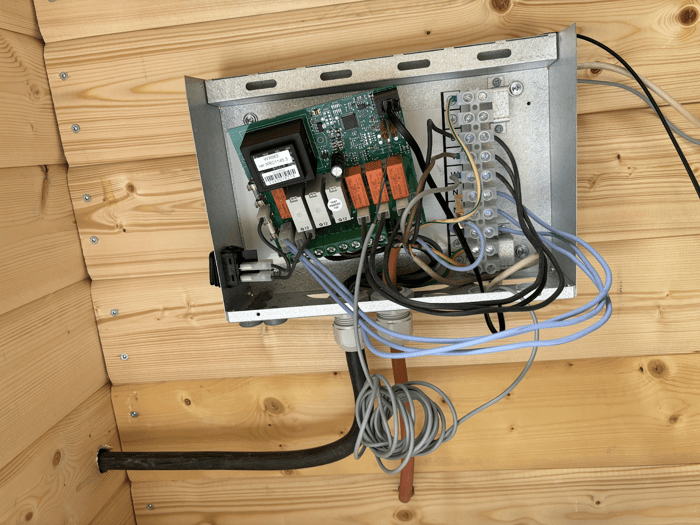
The power requirements for a sauna room depend on its size, so there are different power requirements for different sauna sizes. This power is measured in kilowatts (kW).
To calculate the appropriate size of heater required, you need to know the dimensions of your sauna. It is simple:
Multiply the room's length, width, and height, and divide the figure by 1.3 cubic meters or 45 cubic feet.
The rule is 1kW to 1.3 cubic meters (45ft³), so if you have a room with the dimensions 1.5m, 1.5m, and 2m, when you multiply them, you have 4.5m³.
Using the rule, you divide 4.5m³ by 1.3 cubic feet, approximately 3.5 kW.
This means that this sauna will need 3.5 kW of power.
Usually, there are factors to consider aside from the room's dimensions.
For example, consider the height of the ceiling. A higher ceiling means more air to heat up, so more time to heat up.
Also, rooms with glass doors or uninsulated walls would take longer to heat up and require more power. You will add 1.4m³ (or 50ft³) to the total dimensions for glass doors and windows.
Flooring of the Sauna Space Matters, Too
Another factor is the tiles, floors, and concrete materials used in the sauna.
They take longer to heat up because they have a high thermal capacity, absorbing a lot of heat before rising in temperature. You should add about 2m³ (or 70ft³).
Power consumption pattern
In addition to the materials and dimensions of the room, it is important to note that the power consumption is not always the same as calculated.
Most saunas only use the full kilowatts calculated when they are turned on because that is when they are at full power.
Traditional electric saunas, for example, use the full kilowatt capacity when turning on and heating up the room and even less power in general because they heat your body directly, not the air.
Let’s put things into perspective:
Let's say it's a medium-sized sauna room with dimensions 2m, 2.2m, and 2.5m, a glass door, and a tiled floor.
The total dimensions will be 11m³ plus 1.4m³ and 2m³ for the flash door and tile floor, respectively.
The total dimensions will come to 14.4m³.
Dividing it by 1.3m³, you will have approximately 11.1 kilowatts so that you can opt for an 11kW heater.
It will always round up, so an 11.5kW heater is also a viable option.
Voltage Requirements for Traditional Electric Sauna Heaters
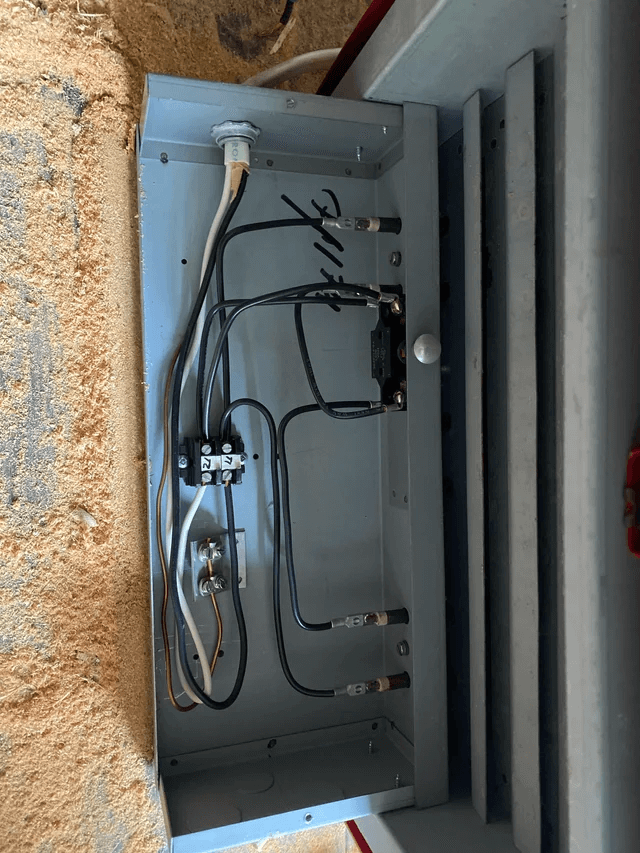
After calculating the kilowatts your sauna heater takes, the voltage needs to be determined.
NOTE:
This is important because if you mismatch the voltage of the phase type, you could burn or destroy the heater, the plug sockets, or the entire electrical panel.
For a 3 kW and above heater, you need a 230V plug (standard socket).
It can also work for 4 to 6 kW, but it has to be hardwired to your electrical panel, while anything above 6 kW needs to be connected to a 3-phase 400V plug.
A 230V plug cannot handle anything above 6 kW comfortably.
You also have to consider the phase power, i.e., the type of power supply. A single phase can handle 3 kW and up to 6 kW, while a 3-phase must come in from 9 or 10 kW above.
The voltage is very important because it greatly affects the heater's performance. For example, a 230V plug can conveniently carry a 3 kW heater, and it would run without tripping off or overheating the power panel.
For installation, 3 kW to 9 kW can easily match a 230V single-phase. From 6 kW, it might need to be hardwired to the general power panel, but it works fine.
What about Sauna Heaters with Higher Kilowatt?
For sauna heaters with higher kilowatts (9 kW above), you need to be connected to a 400V 3-phase power supply to prevent tripping, overheating, and the risk of a fire in your home.
When selecting your heater, ensure that it is compatible with your home's voltage, breaker size, phase type, and wiring system.
Amperage and Circuit Requirements
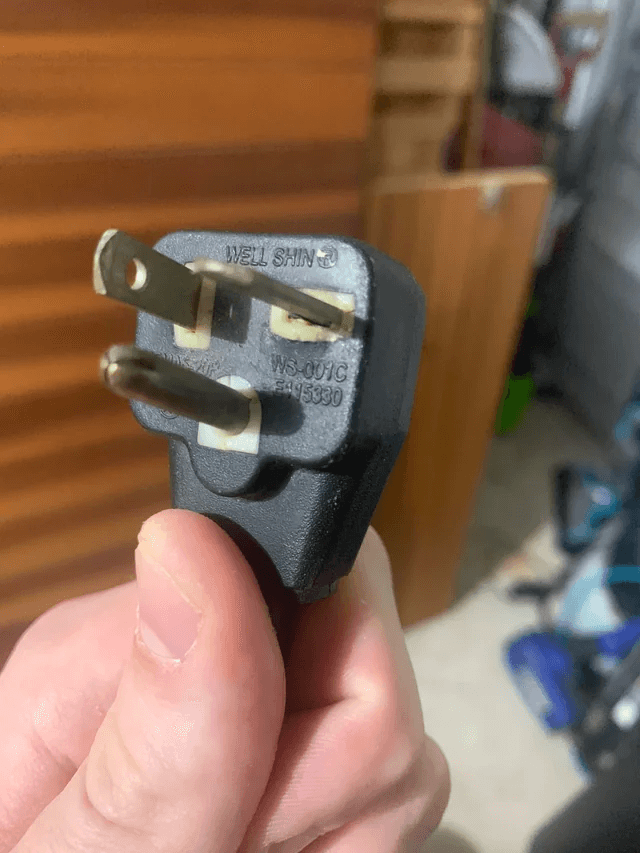
The appropriate amperage of a breaker is calculated by dividing the kilowatts of the heater by the voltage.
For example, a 3 kW heater with a 230V single phase will need approximately 13A. The appropriate size of the breaker will then be 16A as the minimum ampere for the heater.
If a 6 kW heater runs on 230V, the amps are 26A, but you should use a breaker of 32A minimum. Remember that you can always go for a breaker with a higher amperage, like 32A or 50A, for a 16A on a 3 kW heater, but the minimum is 16A.
After you choose the right circuit, ensure that you isolate it and it is not shared with lights, plugs, or any other appliance.
Sauna heaters draw a lot of steady currents that can trip off or affect other appliances. An isolated circuit, on the other hand, will prevent overheating, and the heater will run at full power.
Also, if you can go for a type C breaker, ensure the circuit breaker covers all live wires for the 3-phase sauna heaters. It can handle high inrush currents beyond its capacity before tripping off to prevent damage.
You can also include a Residual Current Device (RCD) or Ground Fault Interrupter (GFCI) for steam or humid saunas.
It will help detect leaks or if water gets into the heater's electric parts, cutting off power to the heater to prevent damage.
Having the proper circuit and a well-protected circuit ensures that your sauna heater runs at a stable and steady pace, lasts longer, and reduces the risk of a fire.
To make things easier, you can use our Sauna Heater Size Calculator.
Wiring Considerations and Best Practices
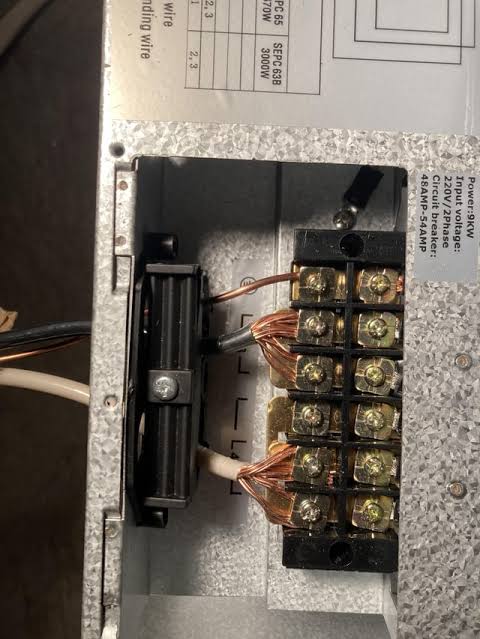
When wiring your sauna heater, you have to consider the following factors:
Heat
Moisture
High current
Quality
Durability
First, the type of wire you use should withstand high temperatures because it will be running into the sauna, where it will constantly be exposed to heat and, sometimes, moisture.
Silicone and rubber-insulated wires are good options.
While silicone-insulated wires can withstand over 180°C, rubber-insulated wires are not, and sometimes are not moisture-resistant.
Silicone and rubber-insulated wires are good options.
While silicone-insulated wires can withstand over 180°C, rubber-insulated wires are durable and moisture-resistant. While PVC cables are good, they will degrade over time.
Ensure that wires are kept outside the sauna as much as possible, and those in the sauna are kept outside the hot zone under heat shields and in place with cable clips to secure the wiring and prevent exposure to radiant light.
If there is a junction box, it should be kept out of the sauna, away from heat, where it can easily be inspected. Sauna heaters should also be grounded to prevent shocks and fire hazards.
What about the Wire Gauge?
Another consideration for wire is the wire gauge. This refers to the thickness and diameter of the wire and is usually measured using the American wire gauge (AWG). The higher the number, the thinner the wire.
You must know the correct wire gauge for your heater. Using a wire that is too thin can cause the circuit breaker to trip, lead to a fire hazard, or damage the heater.
Size Chart for Traditional Sauna Heater Wire Connection
You can use the wire size chart below to determine the length and the AWG of the wire based on the amps of the heater:
Maximum Amps | AWG (Wire Gauge) |
15A | 14 |
20A | 12 |
30A | 10 |
40A | 8 |
55A | 4 |
Quality Heater Options and Their Electrical Specifications
There are a lot of quality heater options out there but here are our top two brands:
1. HUUM Sauna Heaters
Huum DROP Series Electric Sauna Heater - 9kW

$1,676.00
$2,022.50
The DROP electric sauna heater from HUUM is inspired by the purest element in nature – a drop of water. Its handsome and artistic rounded design compliments and softens the angular interior of a classic sauna, creating a more elegant… read more
All HUMM heaters have minimal metal surfaces, creating more surface area for the stones.
This results in more efficient, consistent, and quicker heating while reducing power consumption.
One of HUUM’s award-winning designs is the HUUM DROP Series, which received the Red Dot Award for its minimalistic look inspired by a water droplet and elaborate features.
The wall-mounted HUUM DROP Series is an excellent choice for small and medium saunas.
If you have larger saunas, check out the HUUM HIVE Series, which has a 550-lb stone capacity and can heat up to 1236 cu ft.
Saunas with tight spaces will appreciate the slim design of the HUUM CLIFF Series inspired by the coastal cliffs.
Smaller saunas can use the wall-mounted Mini CLIFF version or the full-sized CLIFF Series that can heat up to 600 cu ft.
NOTE:
The amount of sauna stones HUUM heaters require will depend on the model you choose. The stone capacity is from around 122 lbs to over 500 lbs.
2. Amerec Sauna Heaters
US-based Amerec has over 60 years of experience manufacturing over a million sauna heaters.
The Designer Pure series is the perfect choice if you want something similar but a little more advanced.
The Designer Pure series has three variants: Designer Trend 45S at 4.5 kW, Designer Trend 60 at 6 kW, and Designer Trend 80 at 8 kW. These are suitable for sauna rooms sized 100 to 425 cu ft.
Another favorite of this brand is the Fonda Pure Series, which has a sleeker look, a modern black color, and rounded edges.
The Fonda Pure Series is compatible with A30 or Pure 2.0 controls and available in three variants: Fonda 45 Pure at 4.5kW, Fonda 60 Pure at 6kW, and Fonda 80 Pure at 8kW.
The Amerec Himalaya Pure Series is a heater line that can be a centerpiece in your sauna room. It’s a rock-tower heater with over 210 lbs of stones, comes BTW-ready, and can be used for sauna rooms up to 350 cu ft.
Where To Buy Reliable Heaters For Traditional Electric Saunas
Sauna Heater Supply has various sauna electric heaters and replacement parts, including stones, control units, heating elements, and other accessories.
Our team of sauna-loving experts is also available for a consultation or to help you select the right heater for your space.
Installation Considerations
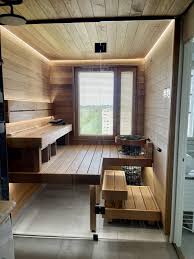
Unless it is a DIY sauna heater, you have to hire a licensed electrician for your sauna heater installation.
Most states require permits and code requirements for electrical installations so you need to check in with your electrical inspector or your local housing authority to know if there are any permits you need to get.
Most of the time, the permit will be obtained by your electrician after he has submitted the wiring diagrams and specifications that you need to install your heater. But this is usually how things would go:
STEP 1: You must get a licensed electrician to inspect your home and explain the installation process.
STEP 2: After the electrician has gotten the permits, he starts with the circuit from the panel box, then begins the wiring, setting the junction box, putting heat-rated wires in the conduit, and grounding for protection.
STEP 3: The next phase is the heater and control wiring for the thermostat, timer, heater, and other connections.
STEP 4: After this, the electrician powers up the heater, checks the sensor readings, the heater, and the control panel's responsiveness, and assesses the heater's performance.
STEP 5: The heater's temperature is checked and adjusted if needed. The balance of airflow and humidity (if the room allows humidity) and the steady state of the circuit are also checked.
After the electrician has tested, the electrical inspector ensures that everything is well-wired and the heater is installed correctly.
After that, routine checks ensure that everything functions as it should.
Usually, once a month is best, and it is good to watch out for heater discoloration, burnt or burning smells, and leaks. The RCD/GFCI should be tested during scheduled maintenance.
Troubleshooting Common Electrical Issues in Traditional Saunas
Over time, after installation, you might have some electrical issues. The first step is to troubleshoot the type of electrical issue so you know what to do.
We prepared this table to serve as a go-to troubleshooting guide for traditional electric-powered saunas:
Issue Type | Likely Cause | Recommended Action |
Heater not turning on | Power supply failure or breaker issue | Troubleshoot as electrical issue; contact a licensed electrician (preferably the installer) |
Heater on but not heating | Heater control system malfunction | Consider a heater malfunction; contact a sauna professional |
Heater overheats or shuts off unexpectedly | Could be both an electrical or heater control system issue | Check both aspects; consult manual or manufacturer before calling a technician or electrician |
Sauna circuit breaker keeps tripping | Excess load on circuit, ground circuit issues | Electrical issue; contact a licensed electrician |
Irregular power supply to sauna | Electrical fault | Electrical issue; contact a licensed electrician |
Remember…
Regardless of what category it falls under, as soon as you've identified the type of problem, wait for a professional to handle it and ask questions to determine what caused it and the best ways to avoid it in the future.
FAQs
What size breaker do I need for my sauna heater?
The size of your circuit breaker is determined by the kilowatts of your sauna heater. A 3 kW heater using a 230V single-phase power supply will require a minimum of 16A.
Can I plug my sauna heater into a standard outlet?
No, you shouldn’t. Even the smallest heaters' kilowatts are too heavy for a standard outlet or socket.
How does my home's electrical system affect my sauna heater options?
Most sauna heaters need to be hardwired into the power panel. Unlike regular appliances such as microwaves or fans, which can easily be plugged into a standard outlet, sauna heaters need to be hardwired into the power panel.

